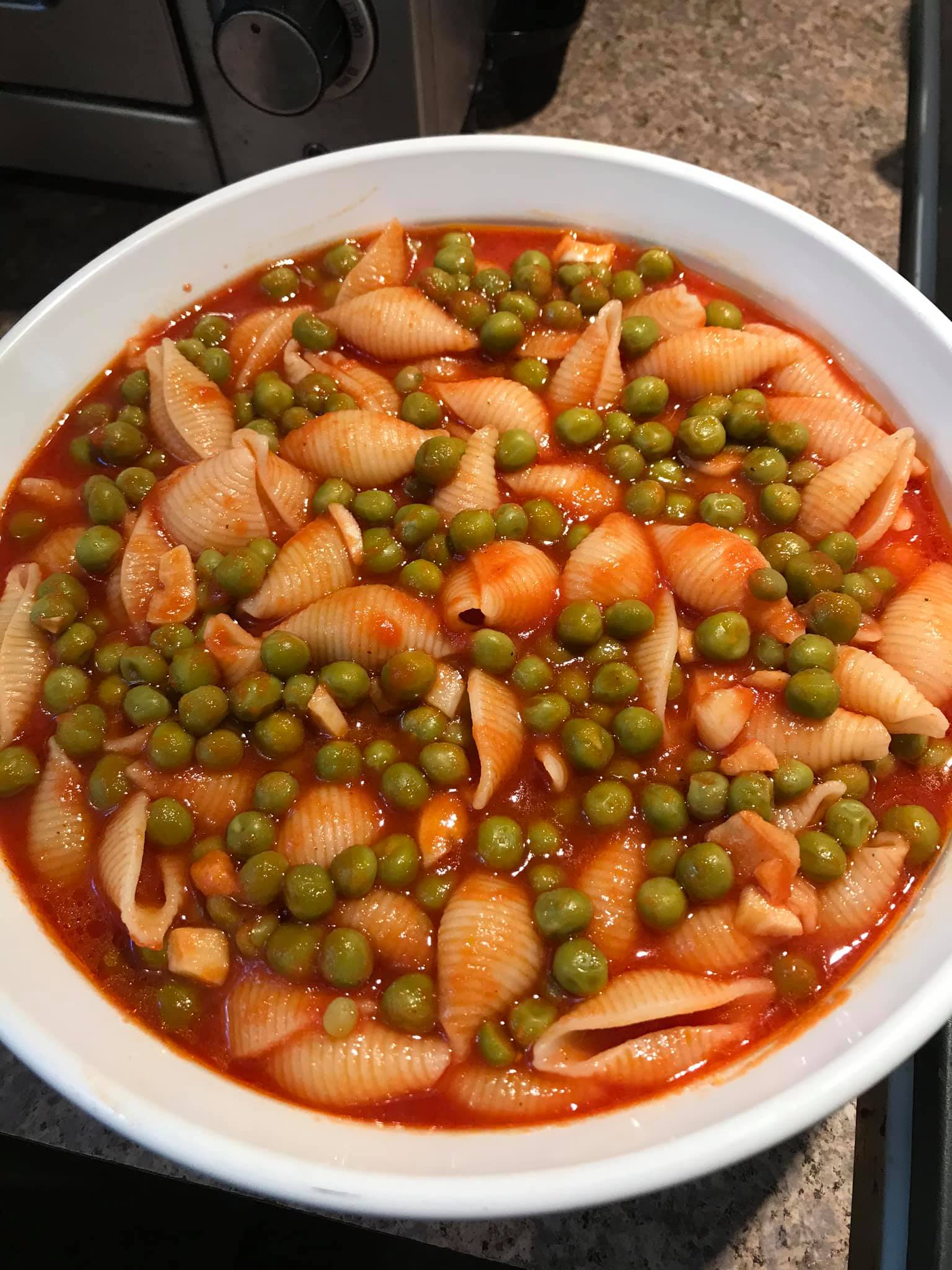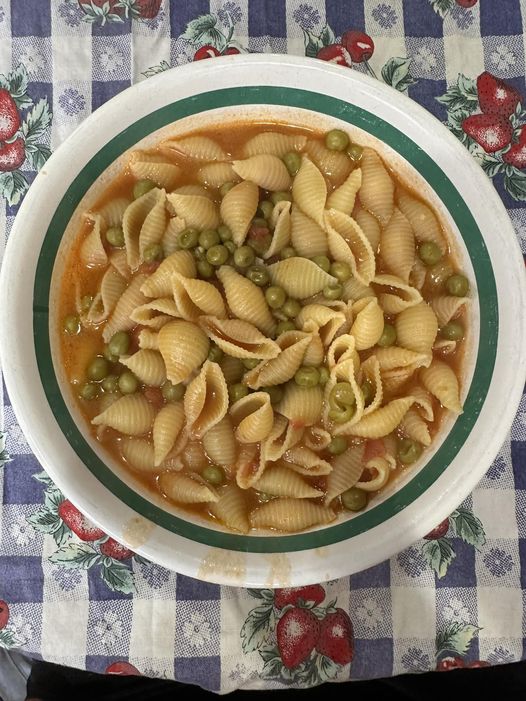Pasta e Piselli (Italian Pasta with Peas)
Simple, rustic, and deeply comforting, Pasta e Piselli is a beloved classic of Italian cucina povera—humble home cooking rooted in tradition.
This dish captures the soul of a nonna’s kitchen: sweet peas simmered in a savory, rosemary-infused broth, with tender pasta shells that hold just enough broth in each bite. Crisp pancetta adds richness and texture, while a hint of tomato and Parmigiano rind deepen the broth’s complexity.
Finished with sharp Pecorino Romano and a drizzle of olive oil, this one-pot meal is both soothing and full of layered flavor. It’s a quiet bowl of warmth that feels like coming home.

Why People Will Love This Pasta e Piselli (Italian Pasta with Peas) Recipe:
A comforting connection to tradition: This dish is steeped in Italian culinary heritage, offering nostalgic flavors that echo generations of home-cooked meals and the simplicity of rustic kitchens.
Balanced simplicity and depth: Though made with everyday ingredients, the layering of pancetta, tomato paste, rosemary, and cheese rind creates a broth that is both savory and deeply nuanced.
Hearty, yet light: Unlike heavy cream-based pasta dishes, this version is brothy and soul-warming—substantial enough to satisfy, yet gentle on the palate.
A complete one-pot meal: With protein from pancetta, vegetables from peas and aromatics, and pasta for comfort, it’s a wholesome, well-rounded dish perfect for lunch or dinner.
Perfect for all seasons: Warm and soothing in the colder months, yet fresh and light enough to enjoy in spring and summer thanks to the peas and fresh herbs.
Highly adaptable: Whether you use vegetable or chicken broth, shell pasta or ditalini, fresh or frozen peas—this dish adjusts easily to what’s on hand without sacrificing flavor.

Key Ingredients:
Pancetta: Salty, rich, and slightly smoky, pancetta renders its fat slowly, infusing the dish with deep umami and forming the flavorful backbone of the broth—its crisp bits later added for texture and contrast.
Yellow onions & garlic: These humble aromatics offer sweetness and savory depth as they soften into the base, creating warmth and balance that underpins every spoonful.
Tomato paste: Just a small amount, toasted in the pan, adds complexity, a hint of acidity, and a rich, concentrated sweetness that subtly elevates the broth without overpowering the peas.
Rosemary: Earthy and aromatic, this woody herb infuses the broth with a fragrant, almost pine-like essence—quiet but essential in grounding the sweetness of peas and onion.
Cheese rind: Simmered slowly, the rind from Parmigiano or Pecorino releases savory, salty, umami notes into the broth, enriching it in a way no salt alone can achieve.
Peas: Tender and sweet, peas bring brightness and a pop of freshness—both visually and in flavor—balancing the richness of pancetta and the creaminess of the broth-soaked pasta.
Pasta shells: Chosen not just for texture but for function—each shell captures just enough broth and peas to deliver a complete flavor experience in a single bite.
Expert Tips:
Render pancetta low and slow: Don’t rush this step. Slow rendering allows the pancetta to crisp evenly and release its full depth of fat and flavor into the base—this fat becomes your flavor gold. Let it quietly sizzle until golden.
Deglaze with intention: When adding broth after caramelizing tomato paste, scrape the bottom of the pot thoroughly. Those browned bits (fond) are rich with pancetta and tomato essence and will amplify the complexity of the broth.
Use a cheese rind: Never skip this. Simmering a Parmigiano or Pecorino rind slowly enriches the broth with layers of umami and subtle nuttiness that can’t be replicated with grated cheese alone.
Parboil pasta separately: Cooking the pasta halfway before adding it to the soup prevents it from soaking up too much broth and becoming bloated or mushy. This keeps the final dish beautifully balanced in texture.
Let peas warm gently: Add peas after removing the rosemary and rind. Avoid boiling them too hard—they should remain vibrant, sweet, and just tender for the best contrast to the savory broth and soft pasta.

How to make Pasta e Piselli (Italian Pasta with Peas)
Ingredients:
1 heaping cup small diced pancetta (about 6 ounces)
2 Tbsp olive oil
2 cups small diced yellow onions
¼ cup chopped garlic
Pinch crushed red pepper
¼ cup tomato paste
2 quarts low- or no-sodium vegetable or chicken broth
2 sprigs rosemary
1 parmigiano or pecorino cheese rind
1 tsp salt, or to taste
½ tsp black pepper, or to taste
1 pound pasta shells + salt for water
4 cups peas or baby peas, defrosted if frozen (about 20 ounces)
Grated Pecorino Romano cheese, for serving
Extra virgin olive oil, for serving
Instructions:
Sep 1: Prep ingredients
Dice, chop, measure, and set out all ingredients for efficient cooking.
Step 2: Render the pancetta
In a large Dutch oven or heavy-bottomed pot, add the pancetta and olive oil over medium-low heat.
Cook slowly for 15–20 minutes until the pancetta is golden and crispy, and most of the fat is rendered.
Step 3: Set pancetta aside
Using a slotted spoon, transfer pancetta to a paper towel-lined plate.
Discard all but 3 tablespoons of the fat from the pot.
Step 4: Sauté aromatics
Add onions, garlic, and crushed red pepper to the pot.
Cook for about 4 minutes, stirring occasionally, until onions begin to soften.
Step 5: Toast tomato paste
Push the onion mixture to one side of the pot.
Add tomato paste to the empty space and cook for 30 seconds, stirring to caramelize slightly.
Step 6: Deglaze and build broth
Pour in 2 cups of broth and stir to loosen any browned bits from the bottom.
Add the remaining broth, rosemary sprigs, cheese rind, salt, and black pepper.
Stir to combine.
Cover partially and bring to a boil over high heat, then reduce to a simmer.
Let simmer for 8–10 minutes until the vegetables are tender.
Step 7: Parboil pasta
In a separate pot, cook the pasta in generously salted water for half the time listed on the package.
Drain and set aside.
Step 8: Finish the soup
Remove the rosemary sprigs and cheese rind from the broth.
Stir in the partially cooked pasta, peas, and reserved pancetta.
Simmer until the pasta is just al dente, stirring occasionally.
Step 9: Season and serve
Taste and adjust seasoning as needed.
Ladle the pasta and broth into bowls.
Top with grated Pecorino Romano cheese and a drizzle of extra virgin olive oil.
Important Notes When Making Pasta e Piselli (Italian Pasta with Peas):
The spirit of the dish is simplicity and balance: Though humble in ingredients, this recipe is a study in layering and restraint. The key is allowing each component—aromatics, tomato, broth, peas, and pasta—to shine without overpowering the others.
Timing matters at every stage: Overcooking pancetta can make it tough; undercooking onions can leave them sharp. Precise timing ensures each element contributes its best texture and flavor to the broth.
Herbs and rind create a broth with soul: Rosemary adds piney brightness while the cheese rind lends savory depth. Simmering them just long enough extracts their essence without letting them dominate.
Texture is essential to authenticity: The pasta should be al dente, the peas tender but not mushy, and the broth silky—not too thick, not too watery. This texture balance defines a good Pasta e Piselli.
Season at the end, not before: Since pancetta, cheese rind, and broth all contain salt, it’s crucial to taste after simmering before adding more. Over-seasoning is easy—discretion is what keeps the dish elegant.
How To Enjoy Pasta e Piselli After Cooking:
Let It Rest Briefly
After cooking, allow the soup to sit uncovered for 5–7 minutes.
This helps the pasta finish absorbing flavor and lets the broth slightly thicken for a richer mouthfeel.
Choose the Right Bowl
Use a wide, shallow bowl rather than a deep one.
This ensures better distribution of peas, pasta, and broth in every bite.
Garnish Like an Italian
Generously grate Pecorino Romano or Parmigiano-Reggiano over the top while the soup is hot.
Finish with a drizzle of high-quality extra virgin olive oil for added richness.
Add Freshness at the Table
If desired, add a few torn fresh basil or parsley leaves just before serving.
A light sprinkle of cracked black pepper can enhance aroma and warmth.
Pair with Bread
Serve with a slice of toasted rustic Italian bread or grilled ciabatta.
Perfect for soaking up the flavorful broth.
Store Leftovers Smartly
Let cool completely and store in an airtight container in the fridge for up to 3 days.
Note: The pasta will absorb more broth, so you may want to thin it with extra stock when reheating.
Reheat Gently
Warm gently on the stovetop over low heat to preserve the pasta’s texture.
Add a splash of broth or water to restore the desired consistency.
Nutrition Information:
Per serving of Pasta e Piselli (Italian Pasta with Peas) — assuming this recipe yields about 8 servings:
Calories: 310 kcal | Total Fat: 10.2 g | Saturated Fat: 3.1 g | Monounsaturated Fat: 4.1 g | Polyunsaturated Fat: 1.2 g | Cholesterol: 18 mg | Sodium: 580 mg (may vary based on broth and cheese) | Total Carbohydrates: 39.6 g | Dietary Fiber: 5.8 g | Sugars: 7.1 g | Protein: 14.4 g
📌 Note: These values are approximate and can vary based on ingredient brands, pasta type, and whether Pecorino Romano and pancetta amounts are adjusted.
Frequently Asked Questions:
Can I make this recipe vegetarian or vegan?
To make it vegetarian, simply use vegetable broth and omit the pancetta and cheese rind.
To make it vegan, also replace the Pecorino Romano with a vegan Parmesan substitute and skip any dairy-based toppings.
What type of pasta works best in this dish?
Short, small-shaped pasta like shells, ditalini, or elbow macaroni is ideal because it catches the peas and broth in each bite.
Avoid long pasta like spaghetti, as it doesn’t blend well with the texture of the soup.
Can I use frozen peas instead of fresh?
Absolutely. Frozen peas are perfect for this recipe. Just thaw them before adding or stir them in frozen during the last few minutes of cooking—they’ll cook quickly.
How do I store and reheat leftovers?
Store the soup in an airtight container in the fridge for up to 4 days.
To reheat, warm gently on the stovetop or in the microwave, adding a splash of broth or water if it has thickened too much.
Can I prepare this dish ahead of time?
Yes, but cook the pasta separately and add it just before serving to avoid it becoming mushy.
You can prepare the broth, peas, and pancetta in advance and store them in the fridge. Assemble and reheat when ready to serve.
Why should I only partially cook the pasta before adding it to the soup?
Partially cooking the pasta separately ensures it finishes cooking in the broth, absorbing the flavor without becoming mushy. It also prevents the soup from getting too starchy or thick too quickly.
Do I need to use a cheese rind, and what does it do?
Using a Parmigiano or Pecorino rind adds rich umami depth and creaminess to the broth as it simmers. While optional, it’s a traditional Italian technique that elevates the flavor profile.
How do I prevent the garlic from burning when sautéing?
Keep the heat at medium or medium-low, and stir frequently. Adding the garlic along with the onions and not before helps it cook gently and prevents bitterness.
Can I substitute pancetta with another ingredient?
Yes. You can use bacon (for a smokier flavor), guanciale, or even mushrooms for a vegetarian alternative. Just make sure to adjust fat and seasoning levels accordingly.
What’s the best way to balance the saltiness in this recipe?
Start with low- or no-sodium broth, and salt in layers—especially after adding the pancetta, cheese, and rind. Always taste and adjust at the end, as the ingredients release salt over time during simmering.